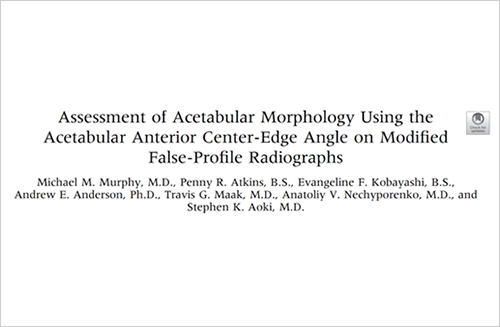Assessment of Acetabular Morphology Using the Acetabular Anterior Centre-Edge Angle on Modified False-Profile Radiographs
Introduction & Methods:
The false profile (FP) view was originally described by Lesquesne and de Seze to assess the onset of early osteoarthritis in the anterior region of the hip joint (with weight bearing) not seen on standard anterior posterior or cross table lateral x-ray views often taken in a supine position. The FP view has more recently been used to assess the anterior hip joint for pincer deformity and signs of hip dysplasia/instability.
This standard FP view gives little information with respect to the presence and size of a cam deformity on the femoral neck. By internally rotating the femur through 35degrees the femoral neck is more easily observed (modified view) and an alpha angle measurement can be taken and this may obviate the need for an additional Dunn x-ray view therefore reducing x-ray time and dose to the patient.
The modified FP technique was published previously by many of the same authors, and a criticism of this was that in the original paper the authors did not discuss whether internally rotating the femur was actually going to move the pelvis and make their measurements of the anterior centre edge angle different to a standardised false profile view. Therefore, the current paper focuses on a standardised false profile view versus a modified false profile view to see whether it changes the orientation of the acetabulum with respect to measuring the ACEA. The major conclusion is that it does not.
The observation that no difference occurs is not surprising, as comparative x-rays were taken (presumably, although this is not clearly stated in the paper) first with the patient was positioned appropriately as per guidelines for standard false profile view and then with a modification of simply internally rotating the foot by 35 degrees, which should not affect the acetabular morphology. Nevertheless, it quantitatively shows that there is no difference, where doubt may have existed.
A limitation at this point in the methodology was there was a lack of descriptive overview of the process of taking both x-ray views, and the reader can therefore only assume the protocol – for example, which image was taken first?, were they taken at the same time, how much gait adjustment was performed by the patient between movements, etc?.
Within the methodology also there is no reference to ethical approval having been received to incorporate this additional x-ray view to all patients (as nobody was excluded) presenting for evaluation of hip pain. While receipt of institutional approval for the purpose of this study is mentioned, incorporation of an additional x-ray view, which appears to have been included for the purpose of answering a specific research question as opposed to for the purpose of any diagnostic rationale, should have required independent ethical approval and certification of such referenced in the methodology.
The ACEA was measured on both views by 2 examiners, and they have then compared the accuracy of the readings in terms of reliability both between the two examiners and also between the two views. From a statistical point of view, while the interclass correlation coefficient (ICC) is an appropriate way to assess any difference between readers, where the purpose is to assess any for difference in measured ACEA between standard and modified false profile views the ICC used in this study for this purpose may not be appropriate. A Bland-Altman plot for example may have been more useful to address this question. While correlation looks at strength of relationship between two variables a Bland-Altman plot would look at difference between techniques – in this case the modified view and the standard false profile view. This would then give you limits of agreement.
What would have been more important to understand is whether these x-rays (either the standardised or modified versions) are repeatable over time, i.e. pre-op to various subsequent follow-up x-rays, and if there is a superiority in the repeatability of either one view over the other. Unfortunately this paper does not address this, which may have been more valuable.
When instability exists, the femoral head may sub lux somewhat and on a standardised false profile view and what may be evident is some asymmetry along the joint because of the inconformity of the head with the socket. When the femoral head is internally rotated (as is the case with the modified version described) it increases the stability of the hip and this may therefore result in an inaccurate measure of instability, should it exists. While this was not the focus of the study, as the modification should not change the assessment of the centre-edge angle, it is an observation which should be acknowledged in the discussion, particularly as the authors propose this modified false profile view as having several advantages compared to the standard false profile view.
Conclusion:
- The title is not reflective of the true scope of the study and does not reflect the results.
- The research question was clear and focused, however understanding of repeatability of the actual modification of the false profile view as described, and how this assesses acetabular morphology is lacking.
- The results suitably state that there is no difference in measuring the ACEA whether this angle is measured on the standard or modified false profile view.
Reviewers
Mr Patrick Carton, Consultant Orthopaedic Surgeon, The Hip and Groin Clinic
Dr Karen Mullins, Research Assistant, UPMC Whitfield
Mr David Filan, Senior Research Assistant, UPMC Whitfield
Ms Mili George, Radiographer, UPMC Whitfield
Ms Aoife Power, Radiographer, UPMC Whitfield
Ms Elica Mukweyna, Radiographer, UPMC Whitfield







